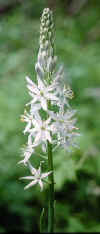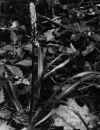| 05-03-04
Many a year ago I was mushroom hunting in one of my favorite woods and
ran across a good friend. As we moved through the woods talking I mentioned
that I would like for my friend to see something very pretty--a wildflower.
Arriving at the spot where I had discovered this raging beauty, my friend
exclaimed: "It is beautiful . . . what is it?"
" I don't know what it is," I said, but I found it yesterday . . . and
shot some pictures . . . perhaps some day I can tell you what it is, but
for now I am satisfied just see it."
That night, when my mushrooms had been processed and were safe in the
frig, I went to my den and opened my Peterson Field Guide To Wildflowers.
In a matter of minutes I had learned that I had stumbled onto a wild
hyacinth (Camassia scilloides).
Sitting there marveling at the picture of this beautiful, powder-blue,
six-petaled flower that made me think of a head of wheat, I wondered if
knowing common and scientific names of this showpiece of nature could somehow
change the value I had attached to it.
The answer to that question came immediately: Certainly not. It was
the beginning of my realization that the wonders of nature are so many
. . . so beautiful . . . and so interesting that one does not have to be
able to attach as common or scientific names to these jewels to enjoy them.
Sure, it is nice and impressive to walk through the woods and recite
for yourself or a companion the names of the wild things we see, but putting
a name to a wildflower, bird, tree or animal should be secondary to enjoying
and respecting these works of the Creator.
But knowing the common and scientific name of this beautiful flower
has not changed the value I have assigned to it one iota. It still is one
of the most beautiful, most interesting, wildflowers I have ever been privileged
to see. And this becomes patently apparent in my mind when I realize that
my rambles in the woods over the years have not put me eyeball-to-eyeball
with another of its kind.
For many springs thereafter, I returned to the spot that was etched
in my mind; until, at length, the spot became somebody's lawn. I never
saw this flower again, there or anyplace else.
Some day, if I am lucky, I will see the wild hyacinth again. But if
and when this happens, this gem of the wild will be no more important to
me than it was when it was nameless.
This thinking is, of course, reflected daily in the spring as legions
of mushroom hunters, nature lovers, and those who adhere to many other
forms of outdoor recreation, take to the woods.
Sure morels are great, and so are the other edible forms of nature's
bounty. But they don't have to have a name, nor do they have to be edible,
to be integral parts of this place where we live . . . planet earth.
ON DOG TRAINING [Note
to Readers: This column was written on May 3, 2004.]
The Joint Advisory Council of the Department of Natural Resources handed
the Division of Fish and Wildlife (DFW) a measure of comeuppance recently
when the wildlife agency sought approval of the panel for its plans to
regulate hunting dog training and trial events off state fish and wildlife
areas and reservoir properties.
The DFW, which has been trying to weasel out of allowing such hunting-dog
activities for several years, sought approval of the advisory group with
a proposed rule change before taking their plan to the DNR Commission.
But the wildlife agency took a sound thrashing when it garnered the vote
of not a single panel member.
The word from the top: This proposed change is at least temporarily
dead. This doesn't mean it won't come back because the anti-hunting dog
element of the DFW is still very much intact.
Click
on thumbnail photo for enlarged view.
 |
 |
Closeup
of the wild hyacinth flower (color)
|
A
full length b&w shot of the plant |
|

